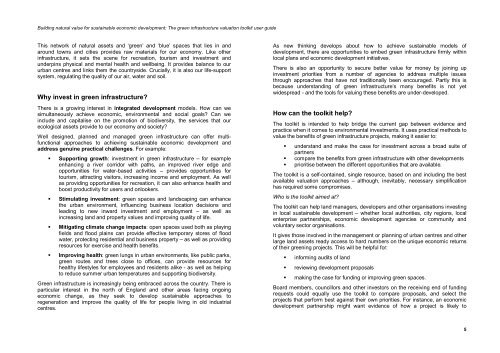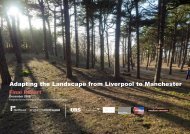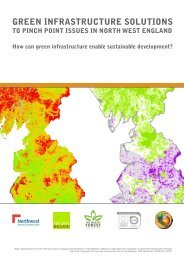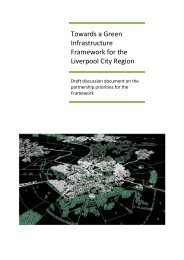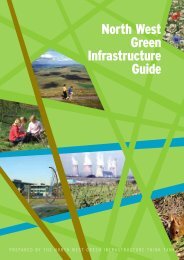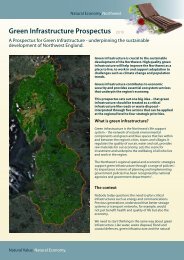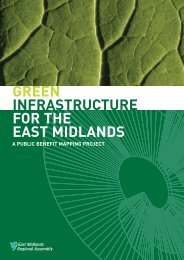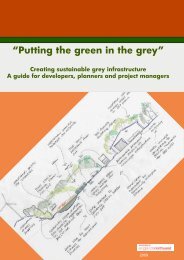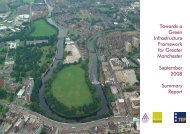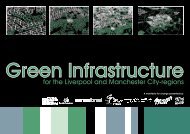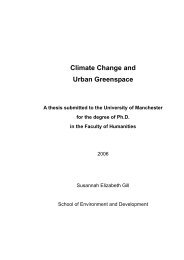The green infrastructure valuation toolkit user guide
The green infrastructure valuation toolkit user guide
The green infrastructure valuation toolkit user guide
You also want an ePaper? Increase the reach of your titles
YUMPU automatically turns print PDFs into web optimized ePapers that Google loves.
Building natural value for sustainable economic development: <strong>The</strong> <strong>green</strong> <strong>infrastructure</strong> <strong>valuation</strong> <strong>toolkit</strong> <strong>user</strong> <strong>guide</strong><br />
This network of natural assets and ‘<strong>green</strong>’ and ‘blue’ spaces that lies in and<br />
around towns and cities provides raw materials for our economy. Like other<br />
<strong>infrastructure</strong>, it sets the scene for recreation, tourism and investment and<br />
underpins physical and mental health and wellbeing. It provides balance to our<br />
urban centres and links them the countryside. Crucially, it is also our life-support<br />
system, regulating the quality of our air, water and soil.<br />
Why invest in <strong>green</strong> <strong>infrastructure</strong><br />
<strong>The</strong>re is a growing interest in integrated development models. How can we<br />
simultaneously achieve economic, environmental and social goals Can we<br />
include and capitalise on the promotion of biodiversity, the services that our<br />
ecological assets provide to our economy and society<br />
Well designed, planned and managed <strong>green</strong> <strong>infrastructure</strong> can offer multifunctional<br />
approaches to achieving sustainable economic development and<br />
address genuine practical challenges. For example:<br />
<br />
<br />
<br />
<br />
Supporting growth: investment in <strong>green</strong> <strong>infrastructure</strong> – for example<br />
enhancing a river corridor with paths, an improved river edge and<br />
opportunities for water-based activities – provides opportunities for<br />
tourism, attracting visitors, increasing income and employment. As well<br />
as providing opportunities for recreation, it can also enhance health and<br />
boost productivity for <strong>user</strong>s and onlookers.<br />
Stimulating investment: <strong>green</strong> spaces and landscaping can enhance<br />
the urban environment, influencing business location decisions and<br />
leading to new inward investment and employment – as well as<br />
increasing land and property values and improving quality of life.<br />
Mitigating climate change impacts: open spaces used both as playing<br />
fields and flood plains can provide effective temporary stores of flood<br />
water, protecting residential and business property – as well as providing<br />
resources for exercise and health benefits.<br />
Improving health: <strong>green</strong> lungs in urban environments, like public parks,<br />
<strong>green</strong> routes and trees close to offices, can provide resources for<br />
healthy lifestyles for employees and residents alike - as well as helping<br />
to reduce summer urban temperatures and supporting biodiversity.<br />
Green <strong>infrastructure</strong> is increasingly being embraced across the country. <strong>The</strong>re is<br />
particular interest in the north of England and other areas facing ongoing<br />
economic change, as they seek to develop sustainable approaches to<br />
regeneration and improve the quality of life for people living in old industrial<br />
centres.<br />
As new thinking develops about how to achieve sustainable models of<br />
development, there are opportunities to embed <strong>green</strong> <strong>infrastructure</strong> firmly within<br />
local plans and economic development initiatives.<br />
<strong>The</strong>re is also an opportunity to secure better value for money by joining up<br />
investment priorities from a number of agencies to address multiple issues<br />
through approaches that have not traditionally been encouraged. Partly this is<br />
because understanding of <strong>green</strong> <strong>infrastructure</strong>’s many benefits is not yet<br />
widespread - and the tools for valuing these benefits are under-developed.<br />
How can the <strong>toolkit</strong> help<br />
<strong>The</strong> <strong>toolkit</strong> is intended to help bridge the current gap between evidence and<br />
practice when it comes to environmental investments. It uses practical methods to<br />
value the benefits of <strong>green</strong> <strong>infrastructure</strong> projects, making it easier to:<br />
<br />
<br />
<br />
understand and make the case for investment across a broad suite of<br />
partners<br />
compare the benefits from <strong>green</strong> <strong>infrastructure</strong> with other developments<br />
prioritise between the different opportunities that are available.<br />
<strong>The</strong> <strong>toolkit</strong> is a self-contained, single resource, based on and including the best<br />
available <strong>valuation</strong> approaches – although, inevitably, necessary simplification<br />
has required some compromises.<br />
Who is the <strong>toolkit</strong> aimed at<br />
<strong>The</strong> <strong>toolkit</strong> can help land managers, developers and other organisations investing<br />
in local sustainable development – whether local authorities, city regions, local<br />
enterprise partnerships, economic development agencies or community and<br />
voluntary sector organisations.<br />
It gives those involved in the management or planning of urban centres and other<br />
large land assets ready access to hard numbers on the unique economic returns<br />
of their <strong>green</strong>ing projects. This will be helpful for:<br />
<br />
<br />
<br />
informing audits of land<br />
reviewing development proposals<br />
making the case for funding or improving <strong>green</strong> spaces.<br />
Board members, councillors and other investors on the receiving end of funding<br />
requests could equally use the <strong>toolkit</strong> to compare proposals, and select the<br />
projects that perform best against their own priorities. For instance, an economic<br />
development partnership might want evidence of how a project is likely to<br />
5


